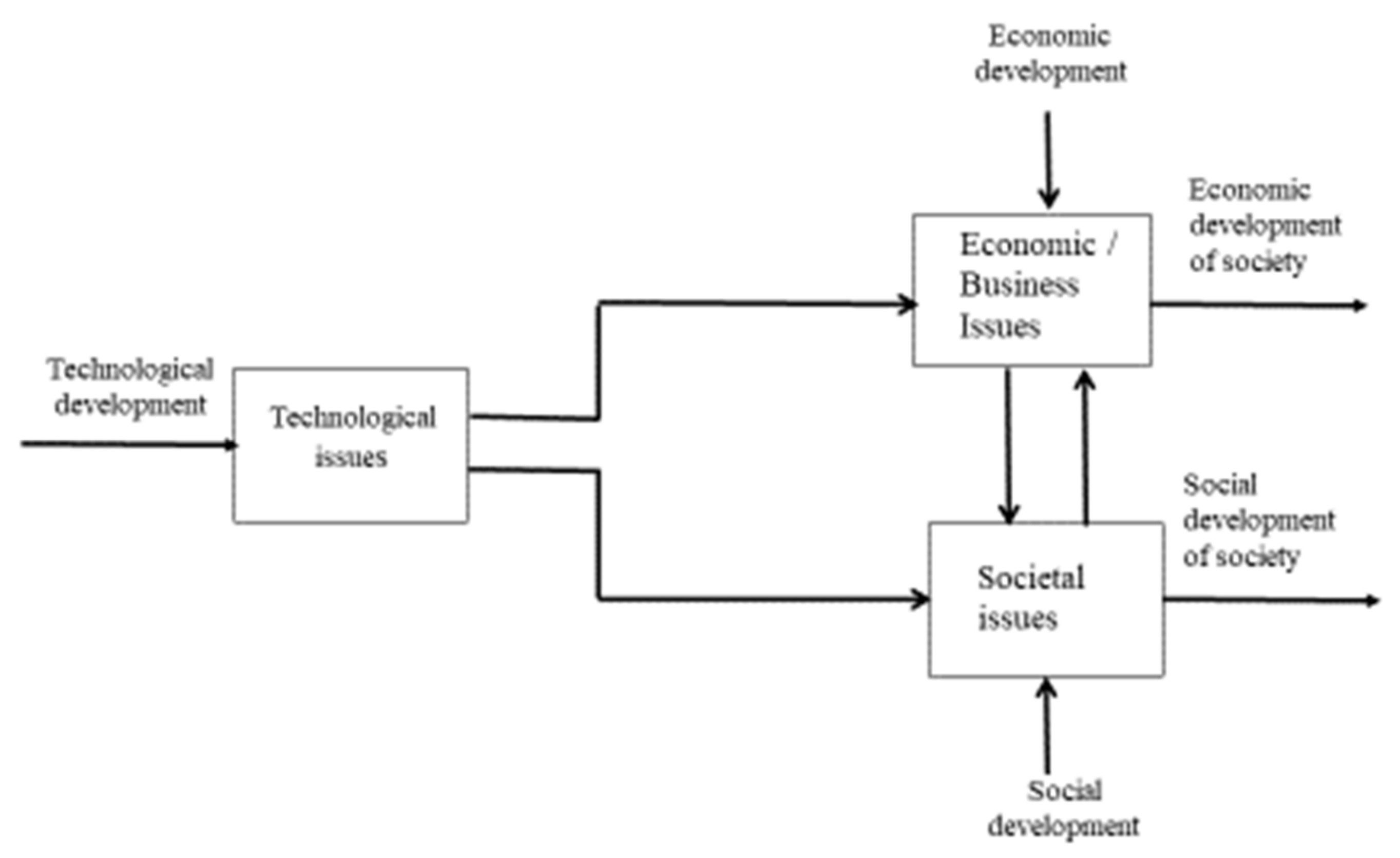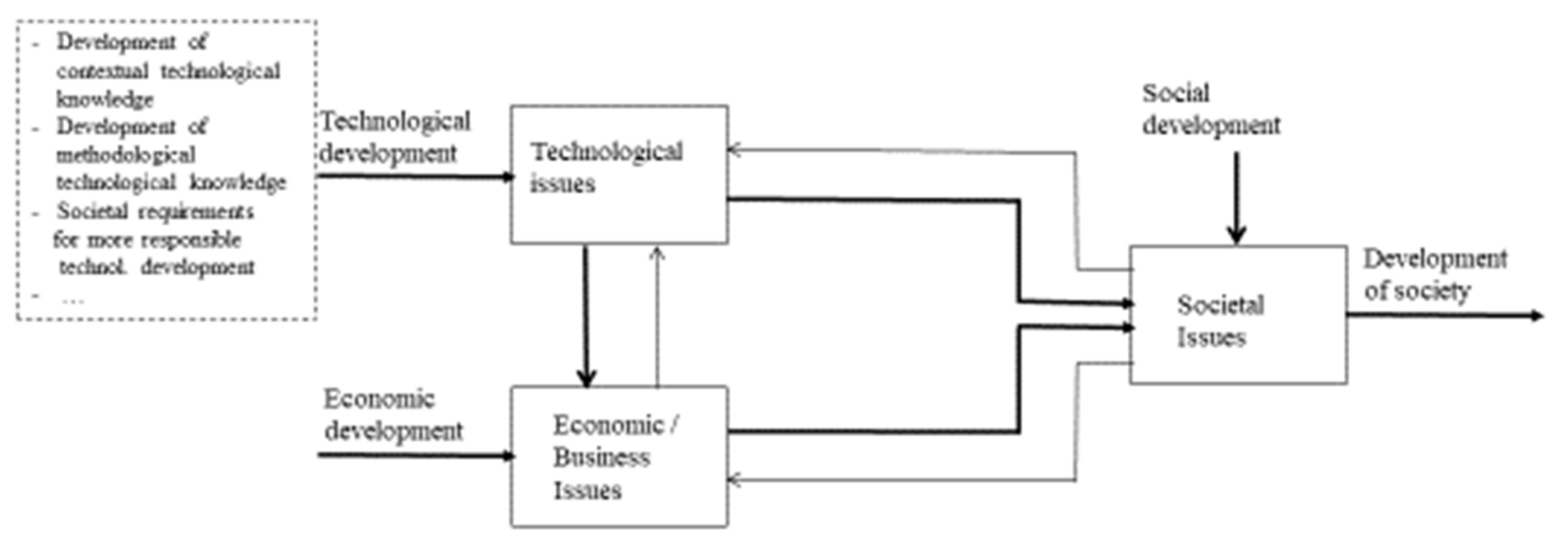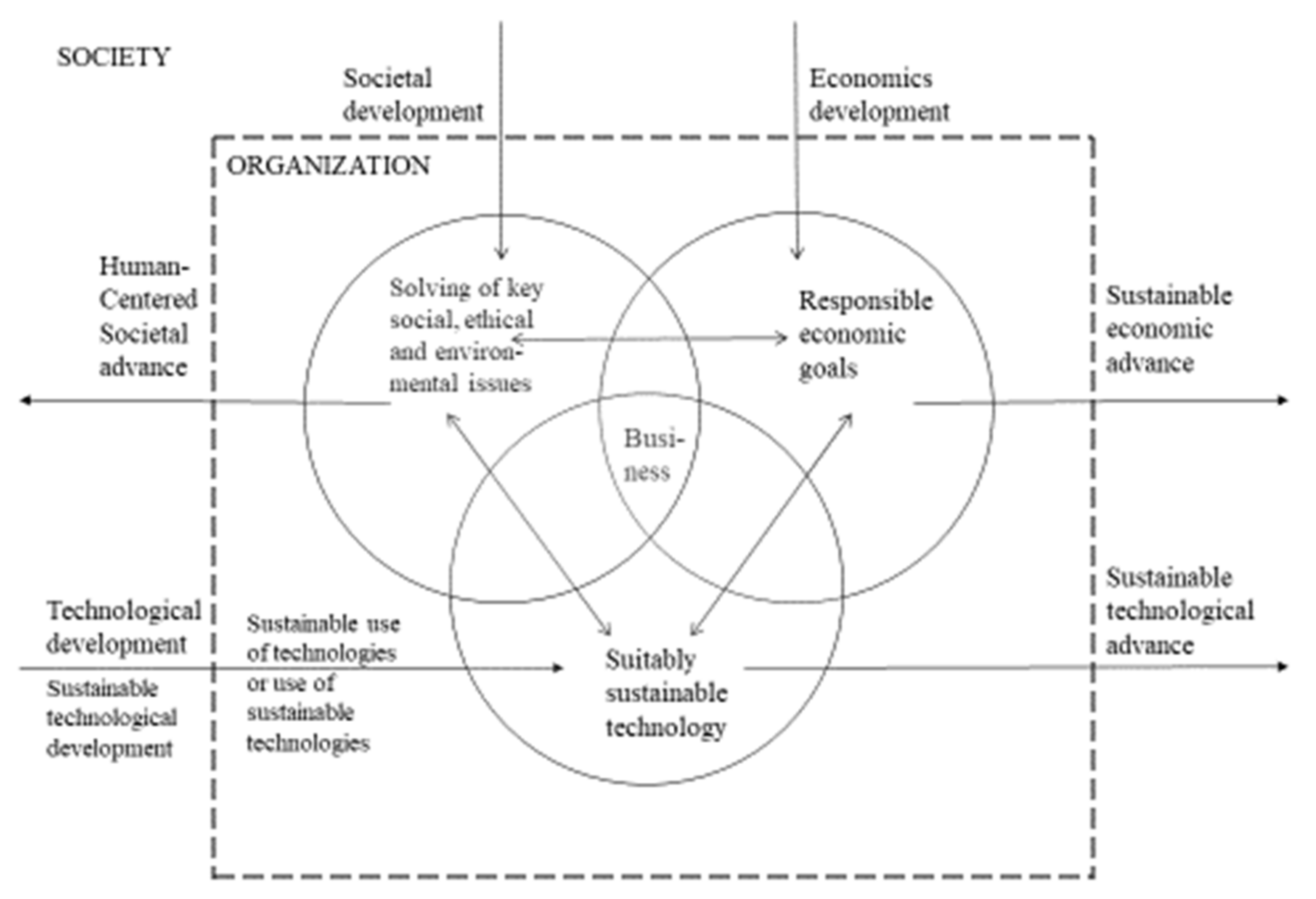Technology and Corporate Social Responsibility
Abstract
:1. Introduction
2. Theoretical Framework and Research Question
2.1. The Role of Technology in Societal Development
2.2. Meaning of Technology for Development of CSR
3. Technology and Corporate Social Responsibility
3.1. CSR in Slovenia
3.2. Sustainability of Technology in Organizations
3.3. Technological and Further Sustainable Development
4. Conclusions
Funding
Institutional Review Board Statement
Informed Consent Statement
Data Availability Statement
Conflicts of Interest
References
- Corsi, A.; Pagani, R.N.; Kovaleski, J.; Luiz da Silva, V. Technology Transfer for Sustainable Development: Economic Impacts Depicted and Some Other Answers to a Few Questions. J. Clean. Prod. 2020, 245, 118522. [Google Scholar] [CrossRef]
- Aguilera, R.V.; Rupp, D.E.; Williams, C.A.; Ganapathi, J. Putting the S Back in Corporate Social Responsibility: A Multilevel Theory of Social Change of Organizations. Acad. Manag. Rev. 2007, 32, 836–863. [Google Scholar] [CrossRef] [Green Version]
- Kemp, R. Technology and the Transition to Environmental Sustainability: The Problem of Technological Regime Shifts. Futures 1994, 26, 1023–1046. [Google Scholar] [CrossRef]
- Healy, S. Science, Technology and Future Sustainability. Futures 1995, 27, 611–625. [Google Scholar] [CrossRef]
- Managi, S.; Lindner, R.; Stevens, C. Technology Policy for the Sustainable Development Goals: From the Global to the Local Level. Technol. Forecast. Soc. Chang. 2021, 162, 120410. [Google Scholar] [CrossRef]
- Elkington, J. Enter the Triple Bottom Line. In The Triple Bottom Line: Does It All Add Up; Henriques, A., Richardson, J., Eds.; Earthscan: London, UK, 2004; pp. 1–16. [Google Scholar]
- Aguinis, H. Organizational Responsibility: Doing Good and Doing Well. In APA Handbook of Industrial and Organizational Psychology; Zedeck, S., Ed.; American Psychological Association: Washington, DC, USA, 2011; Volume 3, pp. 855–879. [Google Scholar]
- Carroll, A. Corporate Social Responsibility: Evolution of a Definitional Construct. Bus. Soc. 1999, 38, 268–295. [Google Scholar] [CrossRef]
- Rego, A.; Cunha, M.P.; Polonia, D. Corporate Sustainability: A View from the Top. J. Bus. Ethics 2017, 143, 133–157. [Google Scholar] [CrossRef]
- Carroll, A.; Shabana, K. The Business Case for Corporate Social Responsibility: A Review of Concepts, Research and Practice. Int. J. Manag. Rev. 2010, 12, 85–105. [Google Scholar] [CrossRef]
- Wang, H.; Tong, L.; Takeuchi, R.; George, G. Corporate Social Responsibility: An Overview and New Research Directions: Thematic Issue on Corporate Social Responsibility. Acad. Manag. J. 2016, 59, 534–544. [Google Scholar] [CrossRef]
- Hansson, S. Technology and the Notion of Sustainability. Technol. Soc. 2010, 32, 274–279. [Google Scholar] [CrossRef]
- Secundo, G.; Ndou, V.; Del Vecchio, P.; De Pascale, G. Sustainable Development, Intellectual Capital and Technology Policies: A Structured Literature Review and Future Research Agenda. Technol. Forecast. Soc. Chang. 2020, 153, 119917. [Google Scholar] [CrossRef]
- Cooper, R.; Foster, M. Sociotechnical Systems. Am. Psychol. 1971, 26, 467–474. [Google Scholar] [CrossRef]
- Glavas, A. Corporate Social Responsibility and Organizational Psychology: An Integrative Review. Front. Psychol. 2016, 7, 1–13. [Google Scholar] [CrossRef] [PubMed] [Green Version]
- Palazzeschi, L.; Bucci, O.; Di Fabio, A. Re-Thinking Innovation in Organizations in the Industry 4.0 Scenario: New Challenges in a Primary Prevention Perspective. Front. Psychol. 2018, 9, 1–30. [Google Scholar] [CrossRef] [Green Version]
- Japan Business Federation (Keidanren). Toward Realization of the New Economy and Society. Reform of the Economy and Society by the Deepening of “Society 5.0”; Keidanren: Tokyo, Japan, 2016. [Google Scholar]
- European Commission (EC). Germany: Industrie 4.0. Digital Transformation Monitor; European Commission: Brussel, Belgium, 2017; Available online: https://ec.europa.eu/growth/tools-databases/dem/monitor/sites/default/files/DTM_Industrie%204.0.pdf (accessed on 15 March 2021).
- Higashihara, T. A Search for Unicorns and the Building of “Society 5.0”; World Economic Forum: Davos, Switzerland, 2018. [Google Scholar]
- Savaget, P.; Geissdoerfer, M.; Kharrazi, A.; Evans, S. The Theoretical Foundations of Sociotechnical Systems Change for Sustainability: A Systematic Literature Review. J. Clean. Prod. 2019, 206, 878–892. [Google Scholar] [CrossRef]
- Ruttan, V. Induced Innovation, Evolutionary Theory and Path Dependence: Sources of Technical Change. Econ. J. 1997, 107, 1520–1529. [Google Scholar] [CrossRef]
- Zwaan, A. The Socio-Technical Systems Approach: A Critical Evaluation. Int. J. Prod. Res. 1975, 13, 149–163. [Google Scholar] [CrossRef]
- Pasmore, W.; Francis, C.; Haldeman, J.; Shani, A. Sociotechnical Systems: A North American Reflection on Empirical Studies of the Seventies. Hum. Relat. 1982, 35, 1179–1204. [Google Scholar] [CrossRef]
- Guo, M.; Nowakowska-Grunt, J.; Gorbanyov, V.; Egorova, M. Green Technology and Sustainable Development: Assessment and Green Growth Frameworks. Sustainability 2020, 12, 6571. [Google Scholar] [CrossRef]
- Federal Ministry of Education and Research (BMBF). The High-Tech Strategy for Germany; Federal Ministry of Education and Research: Berlin, Germany, 2010; Available online: http://www.inovasyon.org/pdf/Germany.HighTechStrategy.pdf (accessed on 15 March 2021).
- Annunziata, M.; Evans, P. The Industrial Internet@Work; General Electric Company: Boston, MA, USA, 2013; Available online: https://www.ge.com/sites/default/files/GE_IndustrialInternetatWork_WhitePaper_20131028.pdf (accessed on 15 March 2021).
- State Council of People’s Republic of China (SC). The Made in China 2025; State Council of People’s Republic of China: Beijing, China, 2015. [Google Scholar]
- Council for Science, Technology and Innovation (SCTI). Society 5.0; Ministry of Sciences and Technology: Tokyo, Japan, 2016; Available online: https://www8.cao.go.jp/cstp/english/society5_0/index.html (accessed on 15 March 2021).
- Japan Business Federation (Keidanren). Society 5.0 for SDGs; Keidanren: Tokyo, Japan, 2019. [Google Scholar]
- Hansmeier, H.; Schiller, K.; Rogge, K. Towards Methodological Diversity in Sustainability Transitions Research? Comparing Recent Developments (2016–2019) with the Past (Before 2016). Environ. Innov. Soc. Transit. 2021, 38, 169–174. [Google Scholar] [CrossRef]
- Foray, D.; Grubler, A. Technology and the Environment: An Overview. Technol. Forecast. Soc. Chang. 1996, 53, 3–13. [Google Scholar] [CrossRef] [Green Version]
- Weaver, P.; Jansen, G.; Grootveld, E.; Spiegel, P. Sustainable Technological Development; Routledge: London, UK, 2017. [Google Scholar]
- Dao, V.; Langella, I.; Carbo, J. From Green to Sustainability: Information Technology and an Integrated Sustainability Framework. J. Strateg. Inf. Syst. 2011, 20, 63–79. [Google Scholar] [CrossRef]
- Brunswicker, S.; Chesbrough, H. The Adoption of Open Innovation in Large Firms. Res. Technol. Manag. 2018, 61, 35–45. [Google Scholar] [CrossRef]
- Kumar, G.; Kim, S.-H.; Lay, C.H.; Ponnusamy, V. Recent Developments on Alternative Fuels, Energy and Environment for Sustainability. Bioresour. Technol. 2020, 317, 124010. [Google Scholar] [CrossRef]
- Nakanishi, H. Modern Society Has Reached Its Limits. Society 5.0 Will Liberate Us; World Economic Forum: Davos, Switzerland, 2019. [Google Scholar]
- Shiroishi, Y.K.; Uchiyama, K.N.; Suzuki, N. Society 5.0: For Human Security and Well-Being. Computer 2018, 51, 91–95. [Google Scholar] [CrossRef]
- Windsor, D. Corporate Social Responsibility: Three Key Approaches. J. Manag. Stud. 2006, 43, 93–114. [Google Scholar] [CrossRef]
- Crifo, P.; Forget, V. The Economics of Corporate Social Responsibility: A Firm-Level Perspective Survey. J. Econ. Surv. 2015, 29, 112–130. [Google Scholar] [CrossRef]
- Dahlsrud, A. How Corporate Social Responsibility is Defined: An Analysis of 37 definitions. Corp. Soc. Responsib. Environ. Manag. 2008, 15, 1–13. [Google Scholar] [CrossRef]
- Bowen, H. Social Responsibilities of the Business-Man; Harper: New York, NY, USA, 1953. [Google Scholar]
- Dunlap, R.; Gallup, G.; Gallup, A. Of Global Concern: Results of the Health of the Planet Survey. Environment 1993, 35, 7–39. [Google Scholar] [CrossRef]
- Hubert, A. Empowering People, Driving Change: Social Innovation in the European Union; Bureau of European Policy Advisers: Brussels, Belgium, 2010. [Google Scholar]
- Jensen, M. Value Maximization and the Corporate Objective Functions. In Breaking the Code of Change; Beer, M., Nohria, N., Eds.; HSB Press: Boston, MA, USA, 2000; pp. 37–57. [Google Scholar]
- Aupperle, K.; Carroll, A.; Hatfield, J. An Empirical Examination of the Relationship between Corporate Social Responsibility and Profitability. Acad. Manag. J. 1985, 28, 446–463. [Google Scholar]
- Campbell, J. Why Would Corporations Behave in Socially Responsible Ways? An Institutional Theory of Corporate Social Responsibility. Acad. Manag. Rev. 2007, 32, 946–967. [Google Scholar]
- Minton, E.; Khale, L. Belief Systems, Religion, and Behavioral Economics; Business Expert Press: New York, NY, USA, 2014. [Google Scholar]
- Shen, J.; Benson, J. When CSR Is a Social Norm. How Socially Responsible Human Resource Management Affects Employee Work Behavior. J. Manag. 2016, 42, 1723–1746. [Google Scholar]
- Whetten, D. What Constitutes a Theoretical Contribution? Acad. Manag. Rev. 1989, 14, 490–495. [Google Scholar] [CrossRef] [Green Version]
- Kish-Gephart, J.; Trevino, L.; Chen, A.; Tilton, J. Behavioral Business Ethics: The Journey from Foundations to Future. In Business Ethics, Business and Society 360; Wasieleski, D., Weber, J., Eds.; Emerald: Bingley, UK, 2019; pp. 3–34. [Google Scholar]
- Kassin, S.; Fein, S.; Markus, H. Social Psychology; Cengage Learning: Belmont, MA, USA, 2017. [Google Scholar]
- Petrenko, O.; Aime, F.; Ridge, J.; Hill, A. Corporate Social Responsibility or CEO Narcissism? CSR Motivations and Organizational Performance. Strateg. Manag. J. 2016, 37, 262–279. [Google Scholar] [CrossRef]
- McWilliams, A.; Siegel, D. Corporate Social Responsibility and Financial Performance: Correlation or Misspecification? Strateg. Manag. J. 2000, 21, 603–609. [Google Scholar] [CrossRef]
- Joung, C.; Carrell, J.; Sarkar, P.; Feng, S. Categorization of Indicators for Sustainable Manufacturing. Ecol. Indic. 2013, 24, 148–157. [Google Scholar] [CrossRef]
- Friedman, M. The Social Responsibility of Business Is to Increase Its Profits. N. Y. Times Mag. 1970, 13, 122–124. [Google Scholar]
- Gregory, P.; Stuart, R. Comparing Economic Systems in the Twenty-First Century; South Western: Mason, OH, USA, 2004. [Google Scholar]
- Kitzmueller, M.; Shimshack, J. Economic Perspectives on Corporate Social Responsibility. J. Econ. Lit. 2012, 50, 51–84. [Google Scholar] [CrossRef] [Green Version]
- Gelfand, M.J.; Aycan, Z.; Erez, M.; Leung, K. Cross-Cultural Industrial Organizational Psychology and Organizational Behavior: A Hundred-Year Journey. J. Appl. Psychol. 2017, 102, 514–529. [Google Scholar] [CrossRef] [PubMed]
- Waddock, S.; Graves, S. The Corporate Social Performance–Financial Performance Link. Strateg. Manag. J. 1997, 18, 303–319. [Google Scholar] [CrossRef]
- European Commission. Country Report Slovania 2020 (Commison Staff Working Document); European Commission: Brussel, Belgium, 2017; Available online: https://ec.europa.eu/info/sites/files/2020-european-semester-country-report-slovenia-en.pdf (accessed on 15 March 2021).
- Potocan, V.; Mulej, M.; Nedelko, Z. Society 5.0: Balancing of industry 4.0, Economic Advancement and Social Problems. Kybernetes Int. J. Syst. Cybern. 2020, 492X, 1–18. [Google Scholar] [CrossRef]
- Potocan, V.; Nedelko, Z.; Peleckiene, V.; Peleckis, K. Values, Environmental Concern and Economic Concern as Predictors of Enterprise Environmental Responsiveness. J. Bus. Econ. Manag. 2016, 17, 685–700. [Google Scholar] [CrossRef] [Green Version]
- Potocan, V.; Mulej, M.; Nedelko, Z. How Economic Crises Effect Employees’ Attitudes towards Socially Responsible Behaviour -Case of Slovenia. East Eur. Manag. Stud. 2019, spec. iss., 152–178. [Google Scholar]
- Nedelko, Z.; Peleckiene, V.; Peleckis, K.; Peleckis, K.; Lapinskiene, G.; Potocan, V. The Impact of Economic Attitudes on Natural and Social Corporate Responsibility-A Comparative Study of Lithuania and Slovenia. Inžinerinąe Ekon. 2019, 30, 362–372. [Google Scholar] [CrossRef]
- Cresnar, R.; Potocan, V.; Nedelko, Z. Speeding Up the Implementation of Industry 4.0 with Management Tools: Empirical Investigations in Manufacturing Organizations. Sensors 2020, 20, 3469. [Google Scholar] [CrossRef] [PubMed]
- Rashad, W.R.; Lazanyi, K.; Potocan, V.; Nedelko, Z. How Does Business Orientation of Manufacturing Enterprises Define the Utilisation of Lean Production? Acta Polytech. Hung. 2020, 17, 7–26. [Google Scholar] [CrossRef]
- Whetten, D.; Clark, S. An Integrated Model for Teaching Management Skills. J. Manag. Educ. 1996, 20, 152–181. [Google Scholar] [CrossRef]
- Whetten, D.; Felin, T.; King, B. The Practice of Theory Borrowing in Organizational Studies: Current Issues and Future Directions. J. Manag. 2009, 35, 537–563. [Google Scholar] [CrossRef]
- Podsakoff, P.; MacKenzie, S.; Podsakoff, N. Sources of Method Bias in Social Science Research and Recommendations on How to Control It. Annu. Rev. Psychol. 2012, 63, 539–569. [Google Scholar] [CrossRef] [Green Version]
- Cera, A. The Technocene or Technology as (Neo)Environment. Techné. Res. Philos. Technol. 2017, 21, 243–281. [Google Scholar] [CrossRef]
- Bisong, P.; Apologun, S. Technology Can Save the Environment. Int. J. Humanit. Manag. Soc. Sci. 2020, 3, 11–19. [Google Scholar] [CrossRef]
- Zhang, Y.; Sun, J.; Yang, Z.; Wang, Y. Critical Success Factors of Green Innovation: Technology, Organization and Environment Readiness. J. Clean. Prod. 2020, 264, 121701. [Google Scholar] [CrossRef]
- Organisation for Economic Co-operation and Development (OECD). The Measurement of Scientific and Technological Activities-Proposed Guidelines for Collecting and Interpreting Technological Innovation Data (Oslo Manual); OECD: Oslo, Norway, 2005. [Google Scholar]
- Agarwal, R.; Prasad, J. A Conceptual and Operational Definition of Personal Innovativeness in the Domain of Information Technology. Inf. Syst. Res. 1998, 9, 204–215. [Google Scholar] [CrossRef]
- Armbruster, H.; Bikfalvib, A.; Kinkela, S.; Lay, G. Organizational Innovation: The Challenge of Measuring Non-Technical Innovation in Large-Scale Surveys. Technovation 2008, 28, 644–657. [Google Scholar] [CrossRef]



Publisher’s Note: MDPI stays neutral with regard to jurisdictional claims in published maps and institutional affiliations. |
© 2021 by the author. Licensee MDPI, Basel, Switzerland. This article is an open access article distributed under the terms and conditions of the Creative Commons Attribution (CC BY) license (https://creativecommons.org/licenses/by/4.0/).
Share and Cite
Potocan, V. Technology and Corporate Social Responsibility. Sustainability 2021, 13, 8658. https://doi.org/10.3390/su13158658
Potocan V. Technology and Corporate Social Responsibility. Sustainability. 2021; 13(15):8658. https://doi.org/10.3390/su13158658
Chicago/Turabian StylePotocan, Vojko. 2021. "Technology and Corporate Social Responsibility" Sustainability 13, no. 15: 8658. https://doi.org/10.3390/su13158658
APA StylePotocan, V. (2021). Technology and Corporate Social Responsibility. Sustainability, 13(15), 8658. https://doi.org/10.3390/su13158658




